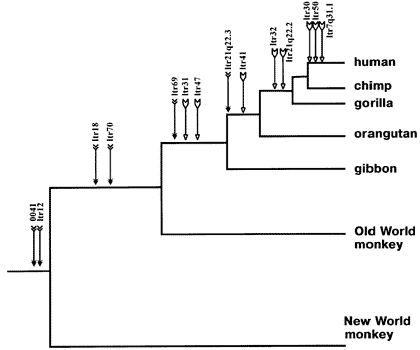For those who have had difficulty in understanding the OP's, I will try and summarize and use analogies where appropriate.
1. A viral genome is inserted into a cell, but the cell is not killed. This is contrary to the normal viral lifecycle. It is a rare occasion when a virus will insert its RNA/DNA and the infected cell doesn't die. An analogy: A person is bitten by a rattlesnake but the venom does not create any reaction in the person who is bitten. Secondly, each viral insertion is random, or nearly random. There are viral insertion hotspots, but this only reduces the chances from 1 in a billion to 1 in 10 million. The chances of two separate viral insertions, by the same virus, occuring at the same spot is very unlikely.
2. The non-lethal viral insertion happens in a germ line cell. This would include eggs or sperm. The cells that make up your functional body, such as organs or muscle, are somatic cells. Germ line cells, in contrast, only serve as reproductive cells. Also, the number of somatic cells outnumber germ line cells by many orders of magnitude. Just guessing, but a ratio of 1:million might be accurate. Therefore, for this to happen in a germ line cell is rare.
3. The infected germ line cell is part of a reproductive event. For instance, out of the million of sperm, 1 or two are infected. One of those sperm end up fertilizing an egg. Again, we are talking about a one in a million chance.
4. This insertion then becomes part of the entire gene pool of a population. This viral insertion must make it from one individual to the entire population over numerous generations. An analogy: Everyone in the world coming into contact with the same dollar bill. This would take time and chance, and not every dollar bill would make it into everyone's hands. Therefore, not every viral insert makes it into the genome of every organism in a population.
Why endogenous retroviral insertions are strong evidence for common descent:
The chances of two populations, not just individuals, of having the same viral insertion in the same exact spot in their DNA sequence is extremely small. Even if two different species were infected by the same virus, the chances of the ineffective virus inserting in the same spot is close to impossible, or highly improbable. Then you have to add in the fact that these ERV's are found throughtout two different populations. Again, this is improbable. However, if your theory is that humans and apes had a common ancestor, and the common ancestor had these viral insertions, then it would be expected that apes and humans would have viral insertions that are identical. This is what we find. The theory of common ancestory explains why a highly improbable event (two different species having the same ERV) is in fact probable.
An analogy: Two students right a 3 billion word thesis. The professor reading the theses finds that they are almost identical. On top of this, the teacher finds that in one paragraph, not only is the wording identical, but the misspellings are identical. Would the teacher conclude that, given the chance of two people misspelling the same word in an identical paragraph is small, the two authors copied off of each other? Or that one author copied off of another? Of course, and for good reason. It is this same reasoning that ERV's support common ancestory between apes and humans.


